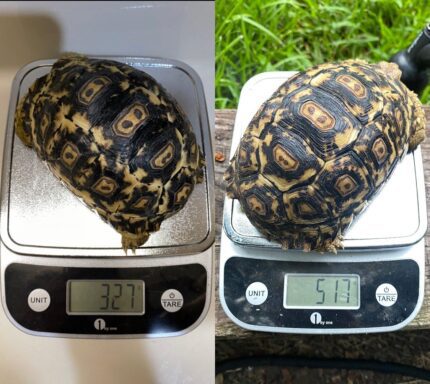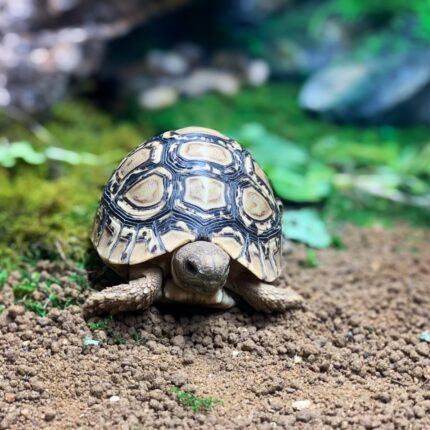Indian star tortoises are easily recognizable by their beautifully star-patterned shells. Typically shy and small, relative to other tortoises, they prefer natural sunlight and life outdoors but can adapt to indoor living with adequate heat, lighting, and humidity. Indian star tortoises are native to the arid climates in India, Pakistan, and Sri Lanka, and are accustomed to monsoon seasons. If their environment isn’t right, they are prone to illness.1 These tortoises are pretty to look at, not big on handling, and are difficult pets to keep.
Indian Star Tortoise Behavior and Temperament
Unlike some other tortoise species, star tortoises are not territorial. And, since they’re small, you can house several of them together. They are not climbers.
Indian star tortoises do not like being handled. They can get stressed out and get ill if handled frequently, so these animals should not live in homes with small children.
Although these tortoises tend to be shy and do not like handling, they may grow more comfortable with an owner’s occasional handling, especially when that owner brings them food. They rarely bite, but a nip may occur if the tortoise thinks a brightly colored toenail or fingernail is a flower petal.
Care for this tortoise is not complicated, but there are many factors you must monitor and maintain daily. Expect to spend at least 45 minutes per day preparing meals, changing the water bowl, and spot cleaning the cage.
Housing the Indian Star Tortoise
Even though they are smaller than most other tortoises, Indian star tortoises still need their space. They can be housed indoors in a large fish tank (55-gallon) or a plastic container, like an under-the-bed box or storage container. They don’t need much height in their enclosure.
And, if you have other pets like cats or dogs, their cage will need to be completely enclosed, at least with a screen top, to protect them from other animals.
Outdoor enclosures should be roughly 6 feet by 6 feet with walls that your tortoise cannot see over. Star tortoises typically don’t dig, so you shouldn’t have to worry about burying the walls in the ground as you would with other types of tortoises. When the tortoise is left unsupervised outdoors, make sure you have a secure covering to safeguard your pet from wild predators, such as birds, raccoons, and opossums.
If you do not live in a dry region similar to their natural habitat, it can be tough to replicate their environment. To complicate matters, the tortoises are accustomed to a heavy rainy season in their native home and will require humidity to thrive.
Heat
As cold-blooded creatures, all reptiles need to regulate their body temperature. If you have an outdoor enclosure, the temperature needs to reach at least 90 degrees. Your tortoise needs a basking spot from 90 to 95 F. At night, the temperature can drop to the 70s, but no lower than that. The enclosure should also have shade spots and a water bowl for the tortoise to fully submerge (and climb out of) to control its temperature. Indoors, your pet’s enclosure will need the same—a basking spot, a shady, hiding place, and a shallow container with clean, fresh water. The indoor enclosure is easier to control by adding or removing heat sources, such as light bulbs, ceramic heaters, and under tank heaters.
Light
These tortoises prefer the outdoors and need ultraviolet rays provided by the sunlight. If kept indoors, tortoises need UVB lighting.2 UVB helps the tortoise process vitamin D3, which affects calcium absorption. Inadequate UV exposure can lead to metabolic bone disease.
Some tortoise owners opt for a mercury vapor bulb, which is a combination UVB and heat light. Although, a 10 percent fluorescent UVB bulb works too. The UVB bulb should stay on for a 12-hour cycle. Replaced the bulb every six months. Even if the bulb doesn’t burn out, the UV rays stop emitting by that time.
Humidity
Provide a moist hide box that reaches up to 80 percent relative humidity and an abundant water bowl with a graduated slope, making it easy for the tortoise to climb in and out. A substrate that maintains humidity like peat moss or soil can also help add moisture to your pet’s enclosure. To accurately monitor the humidity levels, use a hygrometer or humidity gauge, and check the measurements daily.
Substrate
These tortoises need substrate or bedding lining the enclosure made of organic potting soil (chemical- and vermiculite-free), peat moss, coconut fiber, or even hay or grass. Although they are not known to be big diggers, females will shovel down into the substrate to make a shallow nest for eggs.
Food and Water
Star tortoises are herbivores. Give plenty of fresh and dark leafy greens and grasses. Timothy hay, Bermuda grass, orchard grass, ryegrass, alfalfa, and fescue are all acceptable. Never feed your Indian star tortoise dog or cat food.
Fresh greens suitable for tortoises include kale, endive, parsley, dandelion greens, escarole, spineless cactus leaves, and mustard greens; these greens have a higher calcium-to-phosphorus ratio, which is healthier for the star tortoise. Dust an additional calcium powder on their greens daily. Occasionally, you can offer a small bit of fruit as a treat.
Feed it once daily at the same time every day from several food trays spread throughout the enclosure to replicate foraging. Give them as much food as they will eat within 15 to 30 minutes, or you can estimate the pile of food to offer as about the size of the animal’s shell.
Change and clean its water container daily and replenish it with filtered water, if available.
Common Health Problems
Pet tortoises raised in the wild are more likely to suffer from respiratory infections, but they’re relatively common among captive tortoises as well. Respiratory infections usually are caused by unsanitary conditions or insufficient humidity. Early signs of a respiratory infection include wheezing and a lack of appetite. Still, a sick tortoise also may appear lethargic and have excess mucus around its mouth and nasal passages.3
Star tortoises, like most other turtles and tortoises, are susceptible to metabolic bone disease, which occurs when the animal isn’t getting the proper balance of calcium and phosphorous. Tortoises and most other reptiles need exposure to ultraviolet radiation to be able to absorb calcium. Tortoises in the wild typically bask in the sun for most of their waking hours, which is how they get this UV exposure.
If a tortoise doesn’t get enough calcium, its shell may not grow at an average rate. Older star tortoises with metabolic bone disease may have difficulty walking and suffer bone fractures.
These medical conditions are treatable by an exotics veterinarian who specializes in reptiles. Be sure to follow your vet’s directions for care and treatment.
Choosing Your Indian Star Tortoise
Star tortoises are long-lived pets that require a long-term commitment. Depending on when you get your pet and its age, it may outlive you. Some pet owners make arrangements for their pet tortoises in their wills.
If you are set on an Indian star tortoise, your best source will be a reputable breeder. For a local lead on a breeder, inquire at a nearby exotics veterinarian, ask your area reptile rescue, or meet breeders at a regional reptile expo.
Captive-bred animals are less likely to have parasitic infections, and a reputable breeder has information on their breeding, birthdate, and health history. You can expect to pay $600 to $3000; babies usually cost the least and breeding females can generally cost more.
Before bringing it home, examine the tortoise’s shell. Tortoises with patchy dry spots on their shells are likely suffering from shell rot, caused by a fungal infection. If the tortoise seems lethargic or doesn’t eat offered food, it may be ill. A healthy tortoise has clear eyes and skin, and its shell should be smooth and mostly free of blemishes.












Reviews
There are no reviews yet.